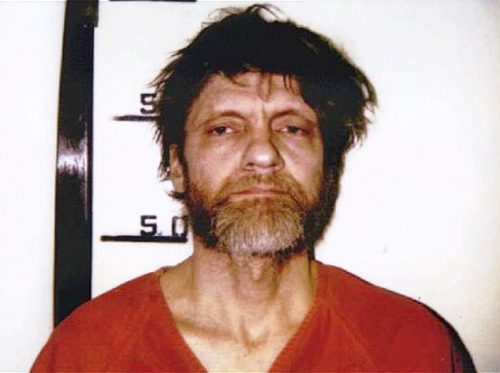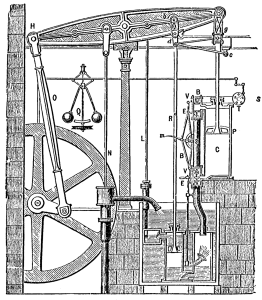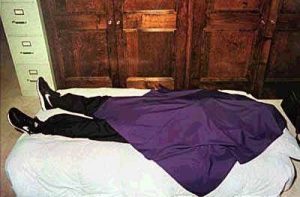Theodore “Ted” Kaczynski, nicknamed the “Unabomber,” killed and injured several people from 1978 to 1995 using mail bombs. Many experts on terrorism have difficulty in establishing whether to consider Ted a terrorist. Some believe he is simply a murderer, while others say that because of his political agenda and his decision to go after certain kinds of people, like science professors and big businessmen, that he should indeed be classified as a terrorist.1
Years before his bombing spree, in 1958, Kaczynski had been a student at Harvard University. The most astounding part is that he was only sixteen years old when he attended his first year as a freshman in college. As a child, Ted had been deemed a gifted student by his teachers. He reportedly had an IQ of 157 at the age of ten. He was allowed to skip sixth grade and work with older students, but he did not like that at all. In his journal, Ted described working with older students as considerably difficult, and he was regularly taunted by them. He never seemed to fit in. During high school, his struggle to be social continued, and he felt isolated from the rest of the students. Despite all of these problems, he still excelled academically and was allowed to skip the eleventh grade. He did have a moment of social fame which came when he made a pipe bomb in one of his science classes, but that moment of fame soon died away and he was alone again.2
During his time at Harvard, Ted continued to have extreme success academically, but still failed to be a part of the college’s social life. He lived in a single room, and some of his classmates recalled the room as messy, and that Kaczynski hardly had any interaction with any of his peers. At Harvard, he joined a study to determine the effects of extreme stress on the human psyche. The study had participants undergo extreme interrogations and personal belittlement over their beliefs and ideals. These interrogations upset Kaczynski, and he began to feel a disdain towards society and authority. According to Alston Chase, a Kaczynski researcher, Ted began to develop a theory to explain his anger and unhappiness. Chase said that, in Ted’s eyes, science and technology were destroying liberty and nature. The “system,” which included Harvard, sought to transform men into automatons to serve the machine by using techniques of behavior modification like propaganda and advertising. Unknowingly, during his undergraduate career, Ted was well on his way to becoming the Unabomber. He completed his undergraduate degree in mathematics in 1962, and went on to graduate school at the University of Michigan. He earned his master’s and Ph.D. in mathematics, and professors often described him as ambitious and talented.3
At that time, the University of California at Berkeley was considered the center of the counterculture movement, and that is where Ted decided to begin his career as a professor. He was uninterested in political activism, and failed, yet again, to become involved with those around him. He didn’t really have the talent to be a teacher and was very unpopular with students. So in January of 1969, he decided to resign his position at the end of the term. He also intended to give up mathematics altogether. His professional and social life began to spiral down after the decisions he had made.4

After his resignation, Kaczynski returned to Illinois, which was where he was born, and lived in a house owned by his parents. He was unemployed, and worked random jobs to get money, as well as borrowing money from his parents. Kaczynski was living as a hermit in the 1970s, and had little interaction with people as he began to sink deeper into his social isolation and anger. He directed all of that anger towards technology and its advancements in society. He began to write about the evils that came with technology and its control over individuals.5 During his time as a hermit, Ted decided to move to Montana where his brother lived. They split the cost of an open piece of land near Lincoln, Montana, and he began to construct a rudimentary cabin that measured 10 by 12 feet and lacked running water, electricity, and heat. Some of his neighbors described him as a quiet man who rode his homemade bicycle and spent a lot of time at the library. He enjoyed reading, and he acquired a substantial collection of volumes that filled his little home. As the decade progressed, he became more and more isolated from society. He returned to Illinois in 1978 and worked at a foam rubber factory where his brother was a supervisor. He was fired by his brother just a few weeks later, after posting insulting limericks around the factory because he had been rejected by a female plant manager. Many believe that this event was the tipping point that began his bombing campaign.6
Ted Kaczynski’s lengthy bombing campaign began on May 25, 1978, when he sent out his first bomb to Northwestern University. The box containing the bomb had a return address with the name of Professor Buckley Crist. The professor was suspicious of receiving a package that she never sent out and asked a campus officer to open it. The bomb detonated and caused the officer minor injuries. Ted then continued his campaign by attempting to bomb an airplane in November of 1979. The bomb detonated in the cargo hold and forced the place to land immediately. This attack sparked the start of a major investigation codenamed “Unabom” because of the university-based targets and the attack on a United Airlines executive.7

Throughout the span of seventeen years, the Unabomber seriously injured more than twenty-two people and killed three. One of the most notable deadly bombings was that of Gilbert Murray, a California timber-industry lobbyist. The package arrived on Monday, April 20. The first person to come in contact with the shoebox-size package was the receptionist who had trouble opening the package and carried it to her boss’ desk. At this point in Kaczynski’s bombing campaign, he had developed much more powerful and deadlier bombs that his previous ones. As Murray started to unwrap the package, it blew up in his hands. The blast killed Murray, forty-seven years old, and was so powerful it knocked two doors off their hinges and blew gashes into the ceiling panels. It was also loud enough that people heard it for blocks around. This startled and scared many people because the Oklahoma City bombing had occurred only five days earlier.8 It turns out that the bomb was never intended to kill Gilbert Murray but instead his predecessor, William Dennison. Dennison was the chief lobbyist for the forest-products trade group from 1980 to 1994 and a highly visible figure in a number of environmental issues. He was replaced by Murray who was killed by a package addressed to Dennison. At that time, William Dennison was seen as the No. 1 person in the timber industry because he was a prominent voice in the Pacific Northwest during the “the timber wars,” which involved environmentalists going up against ranchers, loggers, and the timber industry. Dennison was a key figure in the timber industry and many, including Ted, saw him as a threat to the environment, which could have been a reason why the Unabomber chose him, specifically.9

Around the time of the attack that killed Gilbert Murray, the Unabomber sent a letter to different newspapers, including the New York Times, that offered to stop his bombing spree if they published a manuscript titled “Industrial Society and Its Future,” which would later be known as the “Unabomber Manifesto.” If they did not comply, he threatened that the Freedom Club—”FC” was engraved on all his bombs—would ramp up their terrorist campaign. The manifesto ended up getting published by the Washington Post with help from Time Magazine on September 19, 1995. David Kaczynski, Ted’s brother, read the manifesto and recognized his brother’s writing style from reading unfinished copies that Ted had in his cabin. David contacted the authorities and Ted Kaczynski was arrested in April of 1996 in Montana. In his cabin, they found more than enough evidence, which included bomb-making supplies and early versions of the manifesto, to prove Kaczynski guilty. Two months later, he was charged with several criminal counts relating to the production and distribution of mail bombs. He resisted his lawyers’ efforts of declaring him insane and ended up not being able to represent himself in court. He agreed to a plea deal in 1998 to avoid going to trial. He pled guilty and was sentenced to life in prison without parole, and is still currently serving his sentence.10
- The Greenhaven Encyclopedia of Terrorism, 2007, s.v. “Unabomber, the (1942),” by Patricia D. Netzley. ↵
- Salem Press Encyclopedia of Science, 2013, s.v. “Unabomber case,” by Brion Sever. ↵
- Encyclopedia of World Biography, 2013, s.v. “Ted Kaczynski.” ↵
- Encyclopedia of World Biography, 2013, s.v. “Ted Kaczynski.” ↵
- Salem Press Encyclopedia of Science, 2013, s.v. “Unabomber case,” by Brion Sever. ↵
- Encyclopedia of World Biography, 2013, s.v. “Ted Kaczynski.” ↵
- Salem Press Encyclopedia of Science, 2014, s.v. “Unabomber” by Steve Hewitt. ↵
- Michael Lemonick and Jordan Bontante, “The bomb is in the mail,” Time, May 8, 1995, http://content.time.com/time/magazine/article/0,9171,982900,00.html. ↵
- Kenneth B. Noble, “Bombing in Sacramento: The Investigation; Bomb Meant for Predecessor Of Victim, Officials Say,” The New York Times, April 26, 1995, https://www.nytimes.com/1995/04/26/us/bombing-sacramento-investigation-bomb-meant-for-predecessor-victim-officials-say.html. ↵
- Encyclopedia of World Biography, 2013, s.v. “Ted Kaczynski.” ↵



111 comments
Sebastian Carnero
This was a tragic story but at the same time an interesting one. The details of his past don’t change what he has done, but it is sad how a gifted person who was given great opportunities end doing things as horrible as those in part because of lack of social life. It makes you think the idea of him hating technology, classifying it as evil and using it himself.
Richard Morales
I had very little knowledge of the Unabomber prior to reading this article but now I have learned he was a sick and heinous man. He started off with such a bright mind its a shame he couldn’t use his brilliance with a good purpose. There was something wrong with the man, he was irrational and should have sought help instead of waging his deadly war with technology. Its terrible that it took so long to catch him and he was able to commit multiple deadly acts of terrorism.
Damian Jennings
Ted was a gifted individual but I can understand where his hate comes from, the source was his advanced placement into a higher level of education at a young age. He was always the youngest one of the bunch making him more vulnerable and susceptible to hazing. Being this talented and gifted with knowledge comes with a price, which accounts for his lack of socializing. He could have handled and channeled his anger in a more appropriate way but he chose the wrong path, that’s what make a good person good and a bad person bad. Great read and great article
Donte Joseph
I did not know who or what Ted Kaczynski did but after reading I have a better knowledge. These days with advanced technology, bombers are usually caught within months, but with less technology it is easy to see how it took police years to catch him. I think that had he had a better social life growing up, he might not have been so dark and violent, but I guess we will never know.
Michael Hinojosa
Its kind of weird to find some form of correlation between hating technology and wanting to kill people because of it. But regardless of strange correlations the Unabomber definitely is one of the scariest terrorists in history solely because the feds had such a hard time trying to catch one determined man. This was a great article though I hope to never hear anything detailing the Unabomber ever again!
Hailey Rodriguez
I, of course, have heard of the Unabomber, however, I did not know about his early life and his motivations. It is crazy to think that he was so smart, however, ended up doing nothing good with his life. I can’t help but wonder if he wouldn’t have joined that study at Harvard which made him begin to hate society and authority if it would’ve changed his actions at all.
Harashang Gajjar
Good article,Ted Kaczynski, also known as the “Unabomber,” was born on May 22, 1942, in Illinois. A mathematics prodigy, Kaczynski taught at the University of California at Berkeley before retreating to a survivalist lifestyle in the Montana woods. Between 1978 and 1995, Kaczynski mailed bombs to universities and airlines, killing three people and injuring 23 more. FBI agents arrested Kaczynski in 1996, and two years later he was sentenced to life in prison.
Peter Coons
The Unabomber, I think, will forever live in infamy as the terrorist who was able to circumvent our trust in government the most. It took the feds years to catch him. Even more, the fact he used a service as mundane, yet important, as the postal service to strike his targets is as frightening as it is inspired. As recently as today we see copycat bombers using similar strategy to strike fear in the hearts of thousands. What makes Ted different from his copycats is his Manifesto. Unlike his contemporaries, he was a man with a mission, as diluted as it is, and terror was his vehicle to spread his message. A great article detailing a terrible human being.
Dylan Coons
Its so strange to me that someone would hate technology so much, that they felt like they had to kill people. I have no idea how bombing places would start a revolution that would bring about the end of modern technology as we know it. But, then again most freaks like this don’t make sense so trying to figure it out is pointless. It’s sad that such a genius had to waste his talent killing people. anyway, great article!
Madison Downing
This story is extremely complicated because if we look at his life without knowing what he would do in the future, most of us would feel bad for him. Ted was almost casted out from society because of his powerful mind which would lead to him finding his dark purpose. He never had any proper social interaction because no one liked him and he left that he was being targeted by the world because he was alone… And he needed someone to blame. I find is very crazy because what if he had different interactions with people? Would this have not happened? Who he have been able to become a professor and actually have a family? But at the end of the day there is no excuse that anyone can give him and he should spend the rest of his life in prison for terrorizing innocent people.